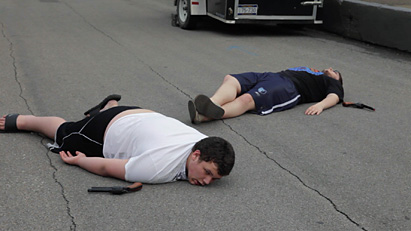deutsch | english |
SOCIAL GLITCH
Radical aesthetics and the consequences of extreme events
Curated by: Sylvia Eckermann, Gerald Nestler, Maximilian Thoman
An exhibition project at KUNSTRAUM NIEDEROESTERREICH 25 09 - 05 12 2015
and in the public space of Vienna with projects in collaboration with TONSPUR Kunstverein Wien and WUK.performing.arts
| WORKS | NEXT > Marc Lombardi (USA) |
Mathias Kessler (AT/USA)
|
|
Mathias Kessler, installation view, photo: Eva Würdinger
Restaging Narratives, Matewan, 2012 – ongoing, video still © Mathias Kessler |
Mathias Kessler (AT/USA)
Hidden Agendas: Jarrells Cemetery, N37º53.96' W81º34.71', Eunice Mountain, West Virginia, 2012 Detail of graveyeard Inkjet print on site-specific wallpaper
Impact CF034499, West Virginia, 2012 Inkjet print on site-specific wallpaper
Restaging Narratives Matewan, 2014 – ongoing media collage, length varies Film stills, installation with projectors or TV set. Four narratives, one history: a 1920's re-enactment of the Matewan Massacre in Matewan, WV filmed in 2012, 2013 and 2014, combined with footage from the 1987 Hollywood movie, Matewan, directed by John Sayles.
On May 19th 1920, the Baldin Felts Detective Agency arrived in Matewan in order to evict families that had been living in a coal camp. The Chief of Police, Sid Hadfield, intervened in the name of the miners and the argument ended in what is known as the Matewan Massacre – a shoot out which left many people from each party dead. Kessler travels to Matewan frequently to explore both the historical social struggle and today's tabletop mining practice in which entire mountain knolls are removed in order to gain quick and cost-effective access to the underlying coal seams. This aggressive form of strip mining leaves a trail of destruction behind that the artist describes as a form of resource-gentrification, which offsets the needs for energy and other materials for growing urban megacities. In West Virginia, whole villages are sacrificed and blown up to get to the coal. Kessler uses digital mapping programs based on algorithms to combine his photographs into large painting-like tableaus. The algorithm creates a discontinuous, partially invented cartography of the photographed landscape. Along these works a video investigates narrative structures and how history is written and enacted. The ongoing film project relates to the shoot out and it's yearly re-enactment. Edited over 4 timelines, viewers see the actual reenactment on May 19th, 2010, a 2011 rehearsal, a special shoot for Kessler in 2014, and sequences of John Sayler's movie Matewan. Kessler's and other people's continued engagement with both the miners and the activists has created new channels of communication across social divides. The community opened a Mining War Museum and has engaged in other ventures that support tourism and local businesses in this economical depressed town. For Kessler "the art piece is a conversation whose cracks open to new realities." |

